![[DBPP]](1_4 Parallel Algorithm Examples_files/asm_color_tiny.gif)





![[Search]](1_4 Parallel Algorithm Examples_files/search_motif.gif)
Next: 1.5 Summary Up: 1
Parallel Computers and Computation Previous: 1.3 A
Parallel Programming Model
We conclude this chapter by presenting four examples of parallel algorithms.
We do not concern ourselves here with the process by which these algorithms are
derived or with their efficiency; these issues are
discussed in Chapters 2 and 3,
respectively. The goal is simply to introduce parallel algorithms and their
description in terms of tasks and channels.
The first two algorithms described have an SPMD structure, the third creates
tasks dynamically during program execution, and the fourth uses a fixed number
of tasks but has different tasks perform different functions.
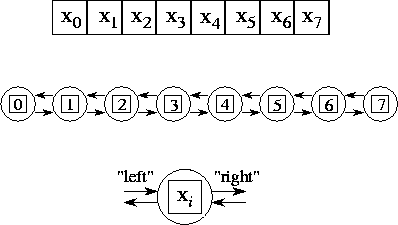
Figure
1.11: A parallel algorithm for the one-dimensional finite
difference problem. From top to bottom: the one-dimensional vector X ,
where N=8 ; the task structure, showing the 8 tasks, each encapsulating
a single data value and connected to left and right neighbors via channels; and
the structure of a single task, showing its two inports and outports.
We first consider a one-dimensional finite difference problem, in which we
have a vector  of size N and
must compute
of size N and
must compute  , where
, where

That is, we must repeatedly update each element of X , with no
element being updated in step t+1 until its neighbors have been updated
in step t .
A parallel algorithm for this problem creates N tasks, one for each
point in X . The i th task is given the value  and is responsible for
computing, in T steps, the values
and is responsible for
computing, in T steps, the values  . Hence, at step
t , it must obtain the values
. Hence, at step
t , it must obtain the values  and
and  from
tasks i-1 and i+1 . We specify this data transfer by defining
channels that link each task with ``left'' and ``right'' neighbors, as shown in
Figure 1.11, and
requiring that at step t , each task i other than task 0 and
task N-1
from
tasks i-1 and i+1 . We specify this data transfer by defining
channels that link each task with ``left'' and ``right'' neighbors, as shown in
Figure 1.11, and
requiring that at step t , each task i other than task 0 and
task N-1
- sends its data
 on its left and right
outports,
on its left and right
outports,
- receives
 and
and  from
its left and right inports, and
from
its left and right inports, and
- uses these values to compute
 .
.
Notice that
the N tasks can execute independently, with the only constraint on execution order being the synchronization
enforced by the receive operations. This synchronization ensures that no data
value is updated at step t+1 until the data values in neighboring tasks
have been updated at step t . Hence, execution is deterministic.
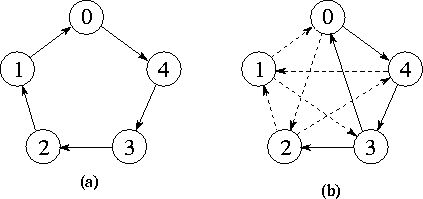
Figure
1.12: Task structures for computing pairwise interactions for
N=5 . (a) The unidirectional ring used in the simple, nonsymmetric
algorithm. (b) The unidirectional ring with additional channels used to return
accumulated values in the symmetric algorithm; the path taken by the accumulator
used for task 0 is shown as a solid line.
Our second example uses a similar channel structure
but requires a more complex communication algorithm. Many problems require the
computation of all N(N-1) pairwise interactions  ,
,  , between N
data,
, between N
data,  . Interactions may be
symmetric, in which case
. Interactions may be
symmetric, in which case  and only
N(N-1)/2 interactions need be computed. For example, in molecular
dynamics we may require the total force vector
and only
N(N-1)/2 interactions need be computed. For example, in molecular
dynamics we may require the total force vector  acting on each atom
acting on each atom  , defined as follows:
, defined as follows:

Each atom is represented by its mass and Cartesian coordinates.  denotes the mutual
attraction or repulsion between atoms
denotes the mutual
attraction or repulsion between atoms  and
and  ; in this
example,
; in this
example,  , so interactions are
symmetric.
, so interactions are
symmetric.
A simple parallel algorithm for the general pairwise interactions problem
might create N tasks. Task i is given the datum  and is responsible for
computing the interactions
and is responsible for
computing the interactions  . One might think that as
each task needs a datum from every other task, N(N-1) channels would be
needed to perform the necessary communications. However, a more economical
structure is possible that uses only N channels. These channels are
used to connect the N tasks in a unidirectional ring (Figure 1.12(a)).
Hence, each task has one inport and one outport. Each task first initializes
both a buffer (with the value of its local datum) and an accumulator that will
maintain the result of the computation. It then repeatedly
. One might think that as
each task needs a datum from every other task, N(N-1) channels would be
needed to perform the necessary communications. However, a more economical
structure is possible that uses only N channels. These channels are
used to connect the N tasks in a unidirectional ring (Figure 1.12(a)).
Hence, each task has one inport and one outport. Each task first initializes
both a buffer (with the value of its local datum) and an accumulator that will
maintain the result of the computation. It then repeatedly
- sends the value contained in its buffer on its outport,
- receives a datum on its inport into its buffer,
- computes the interaction between this datum and its local datum, and
- uses the computed interaction to update its local accumulator.
This send-receive-compute cycle is repeated N-1 times,
causing the N data to flow around the ring. Every task sees every datum
and is able to compute all N-1 interactions involving its datum. The
algorithm involves N-1 communications per task.
It turns out that if interactions are symmetric, we can halve both the number
of interactions computed and the number of communications by refining the
communication structure. Assume for simplicity that N is odd. An
additional N communication channels are created, linking each task to
the task offset  around the ring (Figure
1.12(b)).
Each time an interaction
around the ring (Figure
1.12(b)).
Each time an interaction  is computed between a
local datum
is computed between a
local datum  and an incoming datum
and an incoming datum
 , this value is
accumulated not only in the accumulator for
, this value is
accumulated not only in the accumulator for  but also in another
accumulator that is circulated with
but also in another
accumulator that is circulated with  . After
. After  steps,
the accumulators associated with the circulated values are returned to their
home task using the new channels and combined with the local accumulators.
Hence, each symmetric interaction is computed only once: either as
steps,
the accumulators associated with the circulated values are returned to their
home task using the new channels and combined with the local accumulators.
Hence, each symmetric interaction is computed only once: either as  on the node that holds
on the node that holds
 or as
or as  on the
node that holds
on the
node that holds  .
.
The next example illustrates the dynamic creation of
tasks and channels during program execution. Algorithm 1.1
explores a search tree looking for nodes that correspond to ``solutions.'' A
parallel algorithm for this problem can be structured as follows. Initially, a
single task is created for the root of the tree. A task evaluates its node and
then, if that node is not a solution, creates a new task for each
search call (subtree). A channel created for each new task is used to
return to the new task's parent any solutions located in its subtree. Hence, new
tasks and channels are created in a wavefront as the search progresses down the
search tree (Figure 1.13).
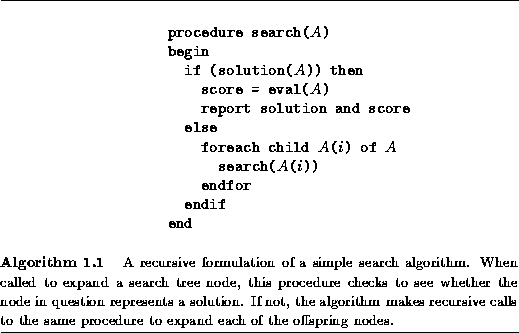
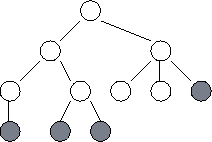
Figure
1.13: Task structure for the search example. Each circle represents
a node in the search tree and hence a call to the search procedure. A
task is created for each node in the tree as it is explored. At any one time,
some tasks are actively engaged in expanding the tree further (these are shaded
in the figure); others have reached solution nodes and are terminating, or are
waiting for their offspring to report back with solutions. The lines represent
the channels used to return solutions.
In so-called embarrassingly parallel problems, a
computation consists of a number of tasks that can execute more or less
independently, without communication. These problems are usually easy to adapt
for parallel execution. An example is a parameter study, in which the same
computation must be performed using a range of different
input parameters. The parameter values are read from an input file, and the
results of the different computations are written to an output file.
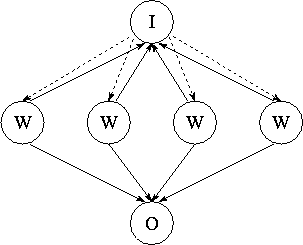
Figure
1.14: Task structure for parameter study problem. Workers (W)
request parameters from the input task (I) and send results to the output task (O). Note the many-to-one connections: this
program is nondeterministic in that the input and output
tasks receive data from workers in whatever order the data are generated. Reply
channels, represented as dashed lines, are used to communicate parameters from
the input task to workers.
If the execution time per problem is constant and each processor has the same
computational power, then it suffices to partition available problems into
equal-sized sets and allocate one such set to each processor. In other
situations, we may choose to use the task structure illustrated in Figure 1.14. The
input and output tasks are responsible for reading and writing the input and
output files, respectively. Each worker task (typically one per processor)
repeatedly requests parameter values from the input task, computes using these
values, and sends results to the output task. Because execution times vary, the
input and output tasks cannot expect to receive messages from the various
workers in any particular order. Instead, a many-to-one communication structure
is used that allows them to receive messages from the various workers in arrival
order.
The input task responds to a worker request by sending a parameter to that
worker. Hence, a worker that has sent a request to the input task simply waits
for the parameter to arrive on its reply channel. In some
cases, efficiency can be improved by prefetching , that is, requesting the next parameter before it is needed.
The worker can then perform computation while its request is being processed by
the input task.
Because this program uses many-to-one communication
structures, the order in which computations are performed is not necessarily
determined. However, this nondeterminism affects only the allocation of problems
to workers and the ordering of results in the output file, not the actual
results computed.
![[DBPP]](1_4 Parallel Algorithm Examples_files/asm_color_tiny.gif)





![[Search]](1_4 Parallel Algorithm Examples_files/search_motif.gif)
Next: 1.5 Summary Up: 1
Parallel Computers and Computation Previous: 1.3 A
Parallel Programming Model
© Copyright 1995 by Ian Foster

![[DBPP]](1_4 Parallel Algorithm Examples_files/asm_color_tiny.gif)





![[Search]](1_4 Parallel Algorithm Examples_files/search_motif.gif)
 of size N and
must compute
of size N and
must compute  , where
, where

 and is responsible for
computing, in T steps, the values
and is responsible for
computing, in T steps, the values  . Hence, at step
t , it must obtain the values
. Hence, at step
t , it must obtain the values  and
and  from
tasks i-1 and i+1 . We specify this data transfer by defining
channels that link each task with ``left'' and ``right'' neighbors, as shown in
Figure
from
tasks i-1 and i+1 . We specify this data transfer by defining
channels that link each task with ``left'' and ``right'' neighbors, as shown in
Figure  on its left and right
outports,
on its left and right
outports,
 and
and  from
its left and right inports, and
from
its left and right inports, and
 .
. 
 ,
,  , between N
data,
, between N
data,  . Interactions may be
symmetric, in which case
. Interactions may be
symmetric, in which case  and only
N(N-1)/2 interactions need be computed. For example, in molecular
dynamics we may require the total force vector
and only
N(N-1)/2 interactions need be computed. For example, in molecular
dynamics we may require the total force vector  acting on each atom
acting on each atom  , defined as follows:
, defined as follows:

 denotes the mutual
attraction or repulsion between atoms
denotes the mutual
attraction or repulsion between atoms  and
and  ; in this
example,
; in this
example,  , so interactions are
symmetric.
, so interactions are
symmetric.
 and is responsible for
computing the interactions
and is responsible for
computing the interactions  . One might think that as
each task needs a datum from every other task, N(N-1) channels would be
needed to perform the necessary communications. However, a more economical
structure is possible that uses only N channels. These channels are
used to connect the N tasks in a unidirectional ring (Figure
. One might think that as
each task needs a datum from every other task, N(N-1) channels would be
needed to perform the necessary communications. However, a more economical
structure is possible that uses only N channels. These channels are
used to connect the N tasks in a unidirectional ring (Figure  around the ring (Figure
around the ring (Figure
 is computed between a
local datum
is computed between a
local datum  and an incoming datum
and an incoming datum
 , this value is
accumulated not only in the accumulator for
, this value is
accumulated not only in the accumulator for  but also in another
accumulator that is circulated with
but also in another
accumulator that is circulated with  . After
. After  steps,
the accumulators associated with the circulated values are returned to their
home task using the new channels and combined with the local accumulators.
Hence, each symmetric interaction is computed only once: either as
steps,
the accumulators associated with the circulated values are returned to their
home task using the new channels and combined with the local accumulators.
Hence, each symmetric interaction is computed only once: either as  on the node that holds
on the node that holds
 or as
or as  on the
node that holds
on the
node that holds  .
.


